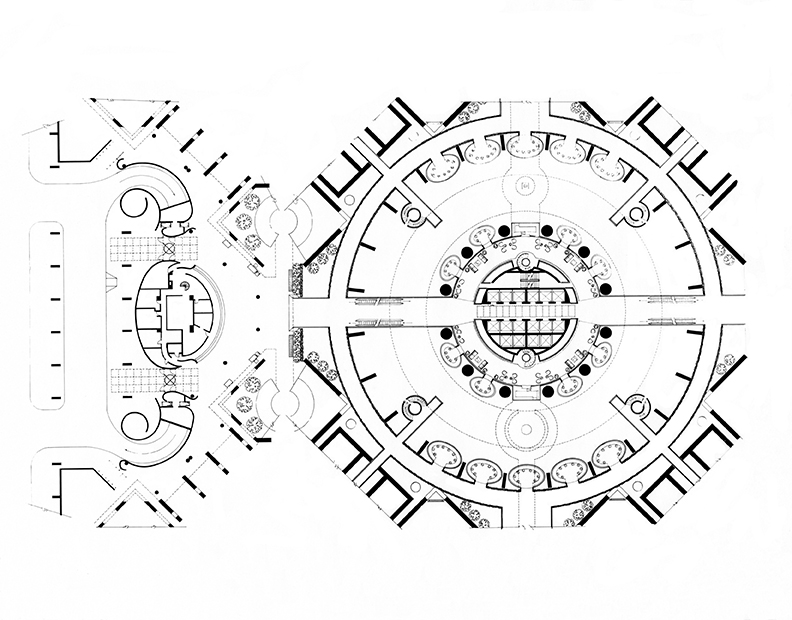
“That is a pretty good example of the atrium typology; appreciation of the project, though, might be a matter of taste.” That was a pretty good-natured assessment of a diagram that I had just drawn, leveled by the instructor of my first-year undergraduate seminar. I had recently visited John Portman’s Hyatt Regency San Francisco and had been struck by the project. When asked to diagram an atrium, I sketched the Hyatt’s skewed pyramidal section, a right triangle roughly parallel with the Embarcadero. Little lozenges with attendant arrows, representing glass elevators, completed the diagram. Given the instructor’s comment, I made a note that Portman’s work might not be something to emulate. I forgot about John Portman for several years.
The instructor, of course, was in good company. For decades, Portman’s atrium hotel projects of the 1970s and 1980s have been skewered within academic discourse on architecture and urbanism. Primary among the critiques is Fredric Jameson’s reading of the Westin Bonaventure Hotel in Los Angeles, immortalized in Postmodernism, or the Cultural Logic of Late Capitalism—a text now thoroughly absorbed into the canon of architectural theory. In his analysis, Jameson links the spatial disorientation that he experienced inside the Bonaventure with the convoluted and opaque character of global capitalism:
It may now be suggested that this alarming disjunction point between the body and its built environment—which is to the initial bewilderment of the older modernism as the velocities of spacecraft to those of the automobile—can itself stand as the symbol and analogon of that even sharper dilemma which is the incapacity of our minds, at least at present, to map the great global multinational and decentered communicational network in which we find ourselves caught as individual subjects.1
Jameson also notes the Bonaventure’s disjunction from its immediate urban context. Other observers of the Bonaventure made this relationship the crux of their critique. The urban theorist Mike Davis attacked the project on multiple fronts, including the troubling racial politics of the redevelopment of LA’s Bunker Hill neighborhood.2 But Davis was also incensed at the Bonaventure’s less-than-transparent relationship with the street, referring to its “fascist obliteration of street frontage.”3 In 2016, as the Western world drops the first hints of a new, very real fascism, this seems like a histrionic quality to assign a building facade. Other urban critiques of Portman’s seminal projects often focus on similar characteristics, if expressed in more restrained language. Architecture critic Bruce Wright, writing about Detroit’s Renaissance Center (a project very similar in parti to the Bonaventure), noted that the project’s blank, concrete facades at street level offered little to pedestrian life, and the project’s interruption of the street grid severed connections with the riverfront.4 Urbanist William H. Whyte, perhaps best known for the aphorism “People will sit where there are places to sit,” was unsettled by the visual and spatial disconnect between various Portman projects and the street.5 Albert Pope addresses Portman’s atriums in his wide-ranging 1996 examination of the American City, Ladders. Pope compounds Jameson’s critique and urban analyses described above:
It’s tempting to include Rem Koolhaas’s piece on Portman, “Atlanta: A Reading,” in this litany as well. But, unsurprisingly, Koolhaas is ambiguous in his position on the work and flickers between earnest interest and a mocking sarcasm identifiably of the 1990s. Writing about Portman, and other Atlanta-based practices, Koolhaas notes, “They have discovered a new realm of potential freedom, to go rigorously with the flow, architecture / urbanism as a form of letting go. Atlanta is a creative experiment, but it is not intellectual or critical: it has taken place without an argument.”6
Despite all these judgments, John Portman’s work is currently in the midst of a critical reevaluation. In 2013, Portman was the subject of a public conversation with faculty at the Harvard Graduate School of Design. He was introduced by historian K. Michael Hays, contextualized by Mariana Ibanez, and interviewed by Dean Mohsen Mostafavi. The latter gently nudged Portman toward a more theoretical dialogue on some of his seminal projects. At one point, Mostafavi displayed Andreas Gursky’s photograph of the Atlanta Hyatt and asked Portman’s opinion—only to receive the reply, “I think it’s beautiful.”7
Later, from the audience, both Preston Scott Cohen and Mack Scogin praised Portman enthusiastically. Scogin singled out his redefinition of the architect’s role in practice and noted his participation in the civil rights movement in Atlanta.8 Cohen stated that the discipline is now in a position to reconsider the architecture of the late twentieth century and called Portman’s atriums “a remarkable invention” and “a supremely important and significant transformational move for the whole discipline.” In 2015, Cohen led a graduate studio titled “Portmanian Architecture,” focusing on contemporary adaptations and new applications of Portman’s tropes.9 (An aside: Mack Scogin Merill Elam Architects, Preston Scott Cohen Inc., and Albert Pope’s practice, Present Future, all contributed to the US Pavilion’s Exhibition at the 2016 Venice Biennale, The Architectural Imagination. Each practice is proposing a large-scale project for Detroit, and like Portman’s Renaissance Center four decades prior, taking on the project of “catalyzing positive changes” in the city.10 Cohen’s project may be especially relevant here; Cynthia Davidson reads it as an inversion of the RenCen, a void instead of a centrifuge.11 Studying these proposals through the lens of Portman’s work bears more investigation.) In addition, Portman was also the subject of a 2012 documentary, which featured praise from critics Paul Goldberger and Herbert Muschamp.


This reevaluation could be attributed to a number of disciplinary trajectories. Architects are moving beyond simple proscriptions regarding scale, street life, and traditional urban patterns, like those made by Jane Jacobs or William H. Whyte. Over the past decade and a half, various architects and theorists have questioned (or attempted to dismantle) notions that position architecture in direct opposition to capital and subsequently real estate development. And a pluralist culture now reigns in most publications and schools, not confining affinities to any one specific formal or ideological approach.
Into this new context comes Interior Urbanism: Architecture, John Portman, and Downtown America by Charles Rice, a professor of architecture at the University of Technology Sydney and editor of The Journal of Architecture. Rice’s ambition is not so much a monograph as a thorough (if selective) reading of Portman’s classic atrium hotels through their role in the urban context.
Rice starts by contextualizing Portman on two fronts. The first chapter includes an examination of the MoMA’s sprawling 1979 survey Transformations in Modern Architecture, curated by Arthur Drexler. Transformations prominently featured Portman’s work. Rice notes that most of the buildings included in the show sidestepped then-current disciplinary narratives and debates revolving around stylistic postmodernism(s). Instead, “Drexler was revealing the sense of a broader modus operandi at work in the profession, that of absorbing workable solutions and proliferating them.”12 Rice follows with a discussion of Jameson’s classic reading of the Bonaventure, and subsequent responses and rereadings by many others, in order to set the table for his own critical approach. Rice’s premise is that the previous understandings of Portman’s work are not explicitly architectural:
This does not just include the effects that Portman’s projects have on urban form. The following chapter takes seriously the interactions between architectural design and John Portman and Associates’ real estate development arm. Another focuses on Portman’s role in urban planning coalitions in Atlanta (with their attendant racial politics more complex and conciliatory than anticipated). Rice’s work here is compelling, succinct, and useful. It confronts reenergized subject matter in a deft and unexpected way. But I could not shake the feeling that, somehow, what is most compelling about Portman’s work is left unsaid, somewhere in the chasm between “postmodern hyperspace” and our current preoccupation with performance.
Memorial Day weekend, I’m back at the Renaissance Center. I’ve stayed at the Marriott here three times before. As a graduate student in Ann Arbor, newly reacquainted with Portman’s work, my wife and I made an annual pilgrimage to the RenCen. We’d stay inside the building for a weekend, drinking at its bars, shopping at its stores, walking its rings. After graduating and moving to Chicago, I made another weekend trip to the RenCen, not once stepping outside, and documented the experience for a thematic journal issue on interior urbanism.13 After repeated visits, the place has not lost any of its hypnotic appeal. But this time I’m not here as an architect. I’m attending a pair of music festivals, both spread across three days in Detroit. One is Movement (formerly Detroit Electronic Music Fest), a celebration of Detroit as the birthplace of techno.14 It takes place across several stages in Hart Plaza, just west of the RenCen. The other is called Trip Metal, a festival of more abstract, improvisational, abrasive strains of electronic music. Both festivals are very loud.

I’m at Movement on Saturday. I mill between a few stages. There’s a showcase for a Detroit-based label that leans toward electro—it’s all kick drum, hi-hat, and bass line, and it’s pretty good. Later, in the underground amphitheater, a DJ known for his residency at a hedonistic Berlin club plays a darker, propulsive type of techno. There are a lot of people who can write about this music eloquently, so I’ll just say this: I love techno like I love the work of Bridget Riley. I love identifying a track’s parts, hearing them overlap, finding new patterns, riding them until, piece by piece, a new form is assembled. The sound is visceral, resonating within my chest. Later, the repetitions circle in my brain until I fall asleep. When I wake up, the hotel room seems like the quietest place that I have ever been.
On Sunday, my wife and I go to Trip Metal. This is a different type of event, aesthetically and politically. Movement costs money—there are wristbands, and beverage tents, and a phalanx of portable toilets. It’s in the heart of downtown. Trip Metal is at a club in Southwest Detroit. This is one of the handful of neighborhoods in the city with an intact fabric and something like an urban population density. Still, the overgrown, provisional character of the city is redolent. Admission to the festival is a pay-as-you-wish donation (due in part to a supporting grant from the Knight Foundation). The beers are cheap. All that said, there are connections between techno and the rougher, noisier, psychedelic music played at Trip Metal. In the past few years, a handful of artists has started to work with one foot in each realm. The tools aren’t always so different.
Describing these kinds of music (noise, or drone, or power electronics) is hard. But everything that we hear on this night is as enveloping as the techno from the day before and violently beautiful in its textures. The sound is a field that saturates the room and cradles your rib cage. Some noises loop; some noises roar…then disintegrate into fields of static. When engaged with this music, it’s almost impossible to tell how much time has passed.
Coming back to the hotel on Sunday night, I decide to aimlessly walk around the RenCen’s concentric rings. In my previous writing about the building, I had suggested that, maybe, another reading of the Portman atrium could be layered atop Jameson’s “postmodern hyperspace” or at least pivoted in a new direction. These spaces spur an understanding of oneself as an urban subject, not only a global consumer. Sure, walking through the Bonaventure or the RenCen gets disorienting—after all these visits, I’m still not always sure where I am, but I do always know what I am in: a circle. This geometry, in its completeness, in its Euclidian legibility, is an inherently collective space. Everyone else here is walking along the same rings and filtering out to the atrium’s periphery. In this way, a Portman atrium isn’t so much an analog for global capital as it is for local collective. It is the city, condensed and circumscribed.
But this night I feel like collectivity is only one part of the atrium’s appeal. Chapter 4 of Rice’s book is titled, “The Geometry of Interior Urbanism.” It is filled with diagrams and useful spatial analyses, demonstrating how Portman’s projects, from his own home at Entelechy, Georgia, to the RenCen, deploy and juxtapose geometries to create urban spatial configurations. As an architect, I find this chapter incredibly useful. But it still doesn’t encapsulate the power of the place.
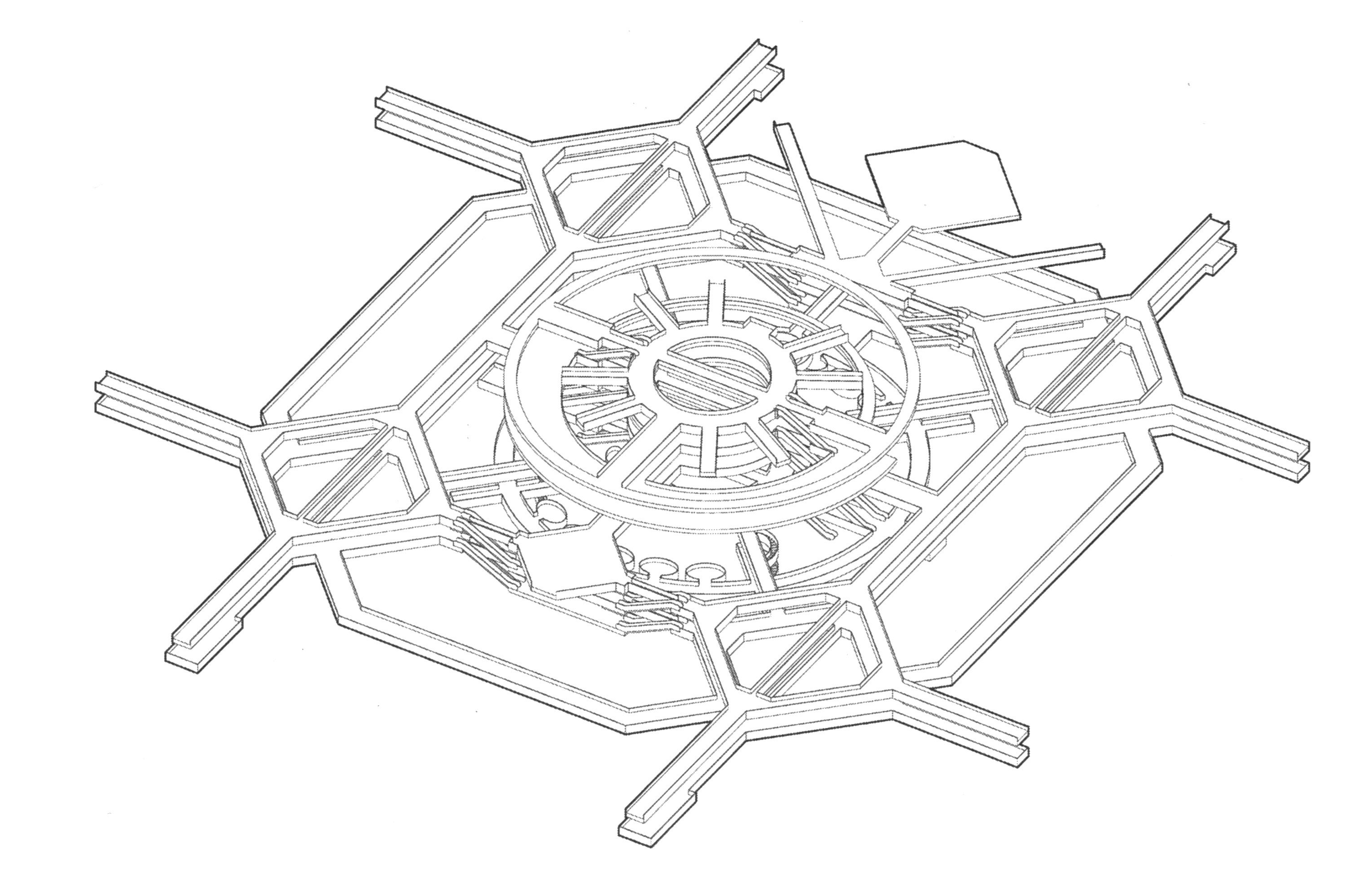
Drawing analogies across art forms is tricky work. We’ve all seen projects whose designer tries to translate the structure or techniques of a piece of music into architecture. That’s not what I intend to do here. But as I’m walking the RenCen this time, I’m trying to understand how this building makes me feel the way that these musics do—the likes of which, of course, didn’t quite exist when it was built (and even if they had, I am not so sure that Portman would have been a fan). The observers of the Portman atrium all hinted at this sensation—what Rice calls “a strange allure.” Reinhold Martin, building upon Jameson’s famous take in a 2008 lecture at the Berlage, specifically discussed the surreal effect of glass elevators:
Portman was fully aware that he was in the business of producing hallucinatory effects. Nicknamed by one of his business partners “The Marijuana Kid,” he said of the Hyatt Regency in Atlanta, “I wanted to explode the hotel, to open it up, take the elevators out of the walls and let them become an experience in and of themselves, let them become a giant kinetic sculpture.”15
Martin was using this, in conjunction with some of Portman’s more humanistic statements regarding people-watching, or communing with nature, to critically demonstrate how the atriums were simultaneously disorienting and domestic and therefore commercially viable. While my interest here is less in elevators and escalators, movement does remain an important factor. Because couldn’t we think about this sensation not as a distraction from the mechanics of our economies but as a valid and meaningful aesthetic experience in its own right? The thumps and drones of this weekend were, for me and many other people, loaded. They took me to meditative spaces, powerful and sublime in their character. Getting lost within them did not mean losing my connection from their realities so much as rolling deeper into their physics. We could think about the atrium of the Renaissance Center in the same way.
The entire atrium is centrifugal around the hotel’s elevator core. The core’s diameter is massive. It is light-colored concrete with a rough surface. The walkways are concrete, too, except for one made of glass and steel that dates to the last decade’s renovation, by SOM. On this walk, I avoid the spaces of that renovation. They are glassy and bright, with a blue-green cast, oriented outward to river and street, like good citizens. They miss the point of this place entirely.
As I walk, the core is always on my left. The geometry renders it magnetic. Walkways are concentric, not stacked. They are distinct orbits. When the walkways intersect a perpendicular bridge, leading across to a lobby or a bank of escalators, or into the core itself, my pace slows. Looking ahead as the path curves and curves and curves, it is like occupying one point and all points, spread across the circle in full, then spilling out at its intersections. My emotional state here is hard to describe; there is a calm and a continuity, but with a quiet terror at its edges. I wonder if this sensation is what Portman meant when he said, “I think it’s beautiful.” Maybe this isn’t what he had in mind at all; maybe it was. I walk for a while—several laps.

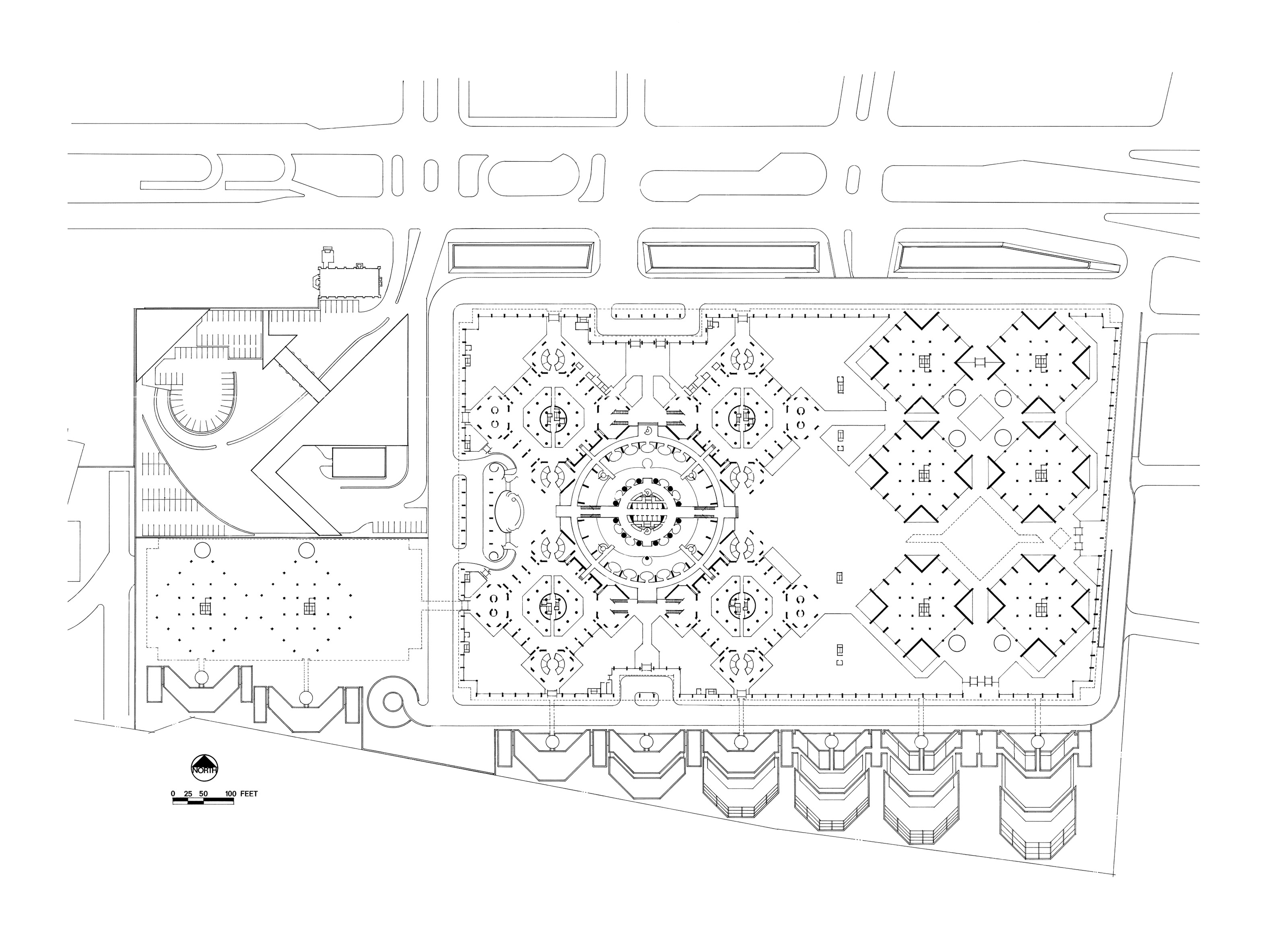
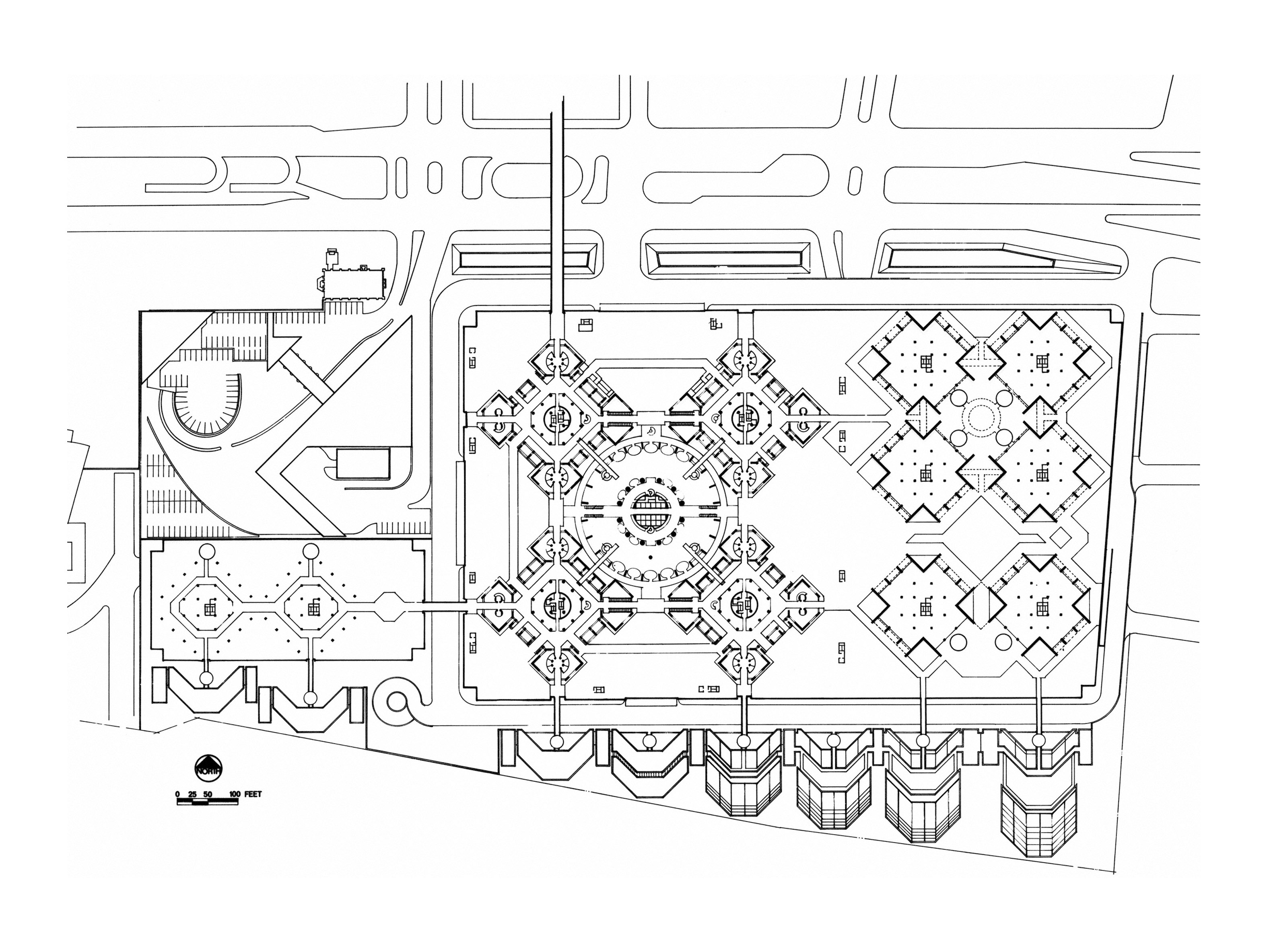
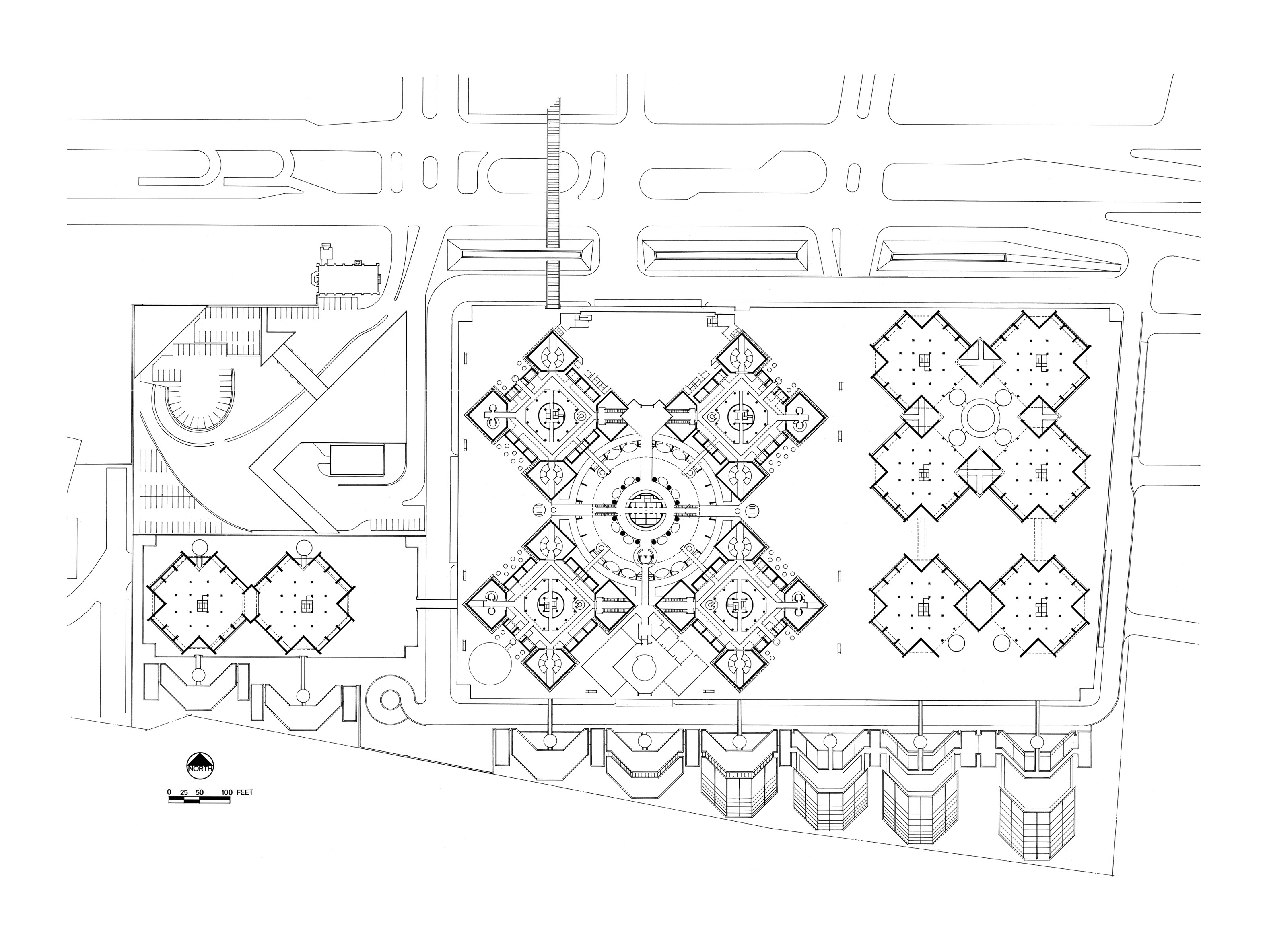
This way of looking at a Portman atrium is not incompatible with Jameson’s reading (or anyone else’s). Instead, let’s think of it as another layer for an object already polyvalent. Fostering sublime aesthetic experiences, even amid banal programs and the prosaic mechanics of commercial life (or the menace of global capital, depending on your politics), should not be a quality outside of architecture’s purview.
At first, it seems like this way of thinking might intersect some recent tropes of architectural theory. There are some initial similarities with the past decade’s exploration of affect and sensation; there might also be some relationship to architectural readings on phenomenology (if a little less sentimental). But the resonance I felt within the Renaissance Center comes from a different place, one not so easily associated with spectacle or seeing oneself seeing. At the RenCen, it is geometry that catalyzes the experience, and the Euclidian nature of that geometry is essential. Look beyond the taxidermied plants and dated finishes, and you are in a ring, simple and exact. That simplicity enabled me to dissolve myself in a way that spaces of much greater geometric complexity could not. Meanings and logics dissolved, too. Not forever, just for a while. Eventually, I took the elevator up to the room.
-
Fredric Jameson, Postmodernism, or the Cultural Logic of Late Capitalism (Durham, North Carolina: Duke University Press, 1991), 43. The eponymous essay from which this passage is taken first appeared in The New Left no. 146, 1984. ↩
-
Bunker Hill, like countless other American urban neighborhoods, was declared blighted in the 1950s. The city of Los Angeles launched the Bunker Hill Urban Renewal Project in 1959, catalyzing decades of demolition. ↩
-
Mike Davis, City of Quartz (London: Verso Books, 1990), 229. Quoted in Albert Pope, Ladders (Princeton, NJ: Princeton Architectural Press, 1997), 130. ↩
-
Bruce Wright, “Megaform Comes to Motown,” Progressive Architecture 59 (February 1978): 60. ↩
-
Quoted in Charles Rice, Interior Urbanism: Architecture, John Portman, and Downtown America (New York and London: Bloomsbury, 2016), 105.
In other words, while it attempts to be nothing if not a celebration of space—some sort of cathedral to the unique spatial biases of contemporary urban production—the inner city atrium is ultimately only a simulated world which is compromised from the outset, unable to acknowledge the far more consequential space its construction brought into being. [^6]
-
Rem Koolhaas, “Atlanta: A Reading,” in Atlanta, eds. Jordi Bernardo, Ramon Prat, and Rem Koolhaas (Barcelona: Actar, 1995), 81. ↩
-
Public Conversation, Harvard GSD, Cambridge, MA, March 12, 2013. Video available online, link. ↩
-
In the ’60s and ’70s, Portman was active in Central Atlanta Progress, an organization with black and white members that explored urban planning issues across racial lines. In a 2009 interview with Forbes magazine, he noted his work with The Action Forum, forwarding integration in Atlanta. ↩
-
Course Syllabus, Harvard GSD, Cambridge, MA. Available online, link. ↩
-
Cynthia Davidson, “The Architectural Imagination,” in Log 37 (Fall 2016): 23. ↩
-
Cynthia Davidson, “The Architectural Imagination,” 31. ↩
-
Rice, Interior Urbanism, 19.
Despite the fervor in the debate that ensued, the Bonaventure, and architecture as a distinct discipline and practice, has, by and large only been treated by urban studies as symbolic to conditions external to it. At risk of submitting to the strange allure of the atrium, in the chapters that follow the aim is to return to Portman’s work [as] an architectural reading, that is, one that attends to its instrumentality relative to urban transformation.[^14]
-
See Jordan Hicks, “24 Hours in the Renaissance Center,” MONU 21 (Autumn 2014): 120–127. ↩
-
Juan Atkins, Derrick May, and Kevin Saunderson—the originators of techno in the 1980s—are from Belleville, Michigan, just outside of Detroit. ↩
-
Reinhold Martin, “The Case of John Portman: From Louis Kahn to the Shanghai Centre,” Lecture, The Berlage Institute, Amsterdam, The Netherlands, June 10, 2008. ↩
Jordan Hicks is an architect based in Chicago. He currently works at Studio Gang.

